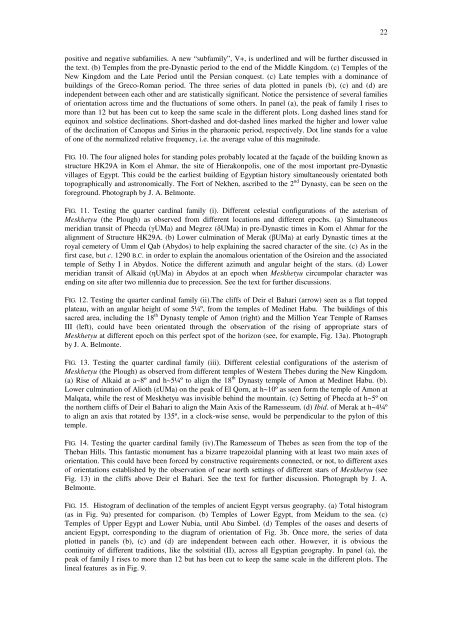“On the orientation of ancient Egyptian Temples: (4 ... - M-shaltout.com
“On the orientation of ancient Egyptian Temples: (4 ... - M-shaltout.com
“On the orientation of ancient Egyptian Temples: (4 ... - M-shaltout.com
Create successful ePaper yourself
Turn your PDF publications into a flip-book with our unique Google optimized e-Paper software.
positive and negative subfamilies. A new “subfamily”, V+, is underlined and will be fur<strong>the</strong>r discussed in<br />
<strong>the</strong> text. (b) <strong>Temples</strong> from <strong>the</strong> pre-Dynastic period to <strong>the</strong> end <strong>of</strong> <strong>the</strong> Middle Kingdom. (c) <strong>Temples</strong> <strong>of</strong> <strong>the</strong><br />
New Kingdom and <strong>the</strong> Late Period until <strong>the</strong> Persian conquest. (c) Late temples with a dominance <strong>of</strong><br />
buildings <strong>of</strong> <strong>the</strong> Greco-Roman period. The three series <strong>of</strong> data plotted in panels (b), (c) and (d) are<br />
independent between each o<strong>the</strong>r and are statistically significant. Notice <strong>the</strong> persistence <strong>of</strong> several families<br />
<strong>of</strong> <strong>orientation</strong> across time and <strong>the</strong> fluctuations <strong>of</strong> some o<strong>the</strong>rs. In panel (a), <strong>the</strong> peak <strong>of</strong> family I rises to<br />
more than 12 but has been cut to keep <strong>the</strong> same scale in <strong>the</strong> different plots. Long dashed lines stand for<br />
equinox and solstice declinations. Short-dashed and dot-dashed lines marked <strong>the</strong> higher and lower value<br />
<strong>of</strong> <strong>the</strong> declination <strong>of</strong> Canopus and Sirius in <strong>the</strong> pharaonic period, respectively. Dot line stands for a value<br />
<strong>of</strong> one <strong>of</strong> <strong>the</strong> normalized relative frequency, i.e. <strong>the</strong> average value <strong>of</strong> this magnitude.<br />
FIG. 10. The four aligned holes for standing poles probably located at <strong>the</strong> façade <strong>of</strong> <strong>the</strong> building known as<br />
structure HK29A in Kom el Ahmar, <strong>the</strong> site <strong>of</strong> Hierakonpolis, one <strong>of</strong> <strong>the</strong> most important pre-Dynastic<br />
villages <strong>of</strong> Egypt. This could be <strong>the</strong> earliest building <strong>of</strong> <strong>Egyptian</strong> history simultaneously orientated both<br />
topographically and astronomically. The Fort <strong>of</strong> Nekhen, ascribed to <strong>the</strong> 2 nd Dynasty, can be seen on <strong>the</strong><br />
foreground. Photograph by J. A. Belmonte.<br />
FIG. 11. Testing <strong>the</strong> quarter cardinal family (i). Different celestial configurations <strong>of</strong> <strong>the</strong> asterism <strong>of</strong><br />
Meskhetyu (<strong>the</strong> Plough) as observed from different locations and different epochs. (a) Simultaneous<br />
meridian transit <strong>of</strong> Phecda (γUMa) and Megrez (δUMa) in pre-Dynastic times in Kom el Ahmar for <strong>the</strong><br />
alignment <strong>of</strong> Structure HK29A. (b) Lower culmination <strong>of</strong> Merak (βUMa) at early Dynastic times at <strong>the</strong><br />
royal cemetery <strong>of</strong> Umm el Qab (Abydos) to help explaining <strong>the</strong> sacred character <strong>of</strong> <strong>the</strong> site. (c) As in <strong>the</strong><br />
first case, but c. 1290 B.C. in order to explain <strong>the</strong> anomalous <strong>orientation</strong> <strong>of</strong> <strong>the</strong> Osireion and <strong>the</strong> associated<br />
temple <strong>of</strong> Sethy I in Abydos. Notice <strong>the</strong> different azimuth and angular height <strong>of</strong> <strong>the</strong> stars. (d) Lower<br />
meridian transit <strong>of</strong> Alkaid (ηUMa) in Abydos at an epoch when Meskhetyu circumpolar character was<br />
ending on site after two millennia due to precession. See <strong>the</strong> text for fur<strong>the</strong>r discussions.<br />
FIG. 12. Testing <strong>the</strong> quarter cardinal family (ii).The cliffs <strong>of</strong> Deir el Bahari (arrow) seen as a flat topped<br />
plateau, with an angular height <strong>of</strong> some 5¼º, from <strong>the</strong> temples <strong>of</strong> Medinet Habu. The buildings <strong>of</strong> this<br />
sacred area, including <strong>the</strong> 18 th Dynasty temple <strong>of</strong> Amon (right) and <strong>the</strong> Million Year Temple <strong>of</strong> Ramses<br />
III (left), could have been orientated through <strong>the</strong> observation <strong>of</strong> <strong>the</strong> rising <strong>of</strong> appropriate stars <strong>of</strong><br />
Meskhetyu at different epoch on this perfect spot <strong>of</strong> <strong>the</strong> horizon (see, for example, Fig. 13a). Photograph<br />
by J. A. Belmonte.<br />
FIG. 13. Testing <strong>the</strong> quarter cardinal family (iii). Different celestial configurations <strong>of</strong> <strong>the</strong> asterism <strong>of</strong><br />
Meskhetyu (<strong>the</strong> Plough) as observed from different temples <strong>of</strong> Western Thebes during <strong>the</strong> New Kingdom.<br />
(a) Rise <strong>of</strong> Alkaid at a~8º and h~5¼º to align <strong>the</strong> 18 th Dynasty temple <strong>of</strong> Amon at Medinet Habu. (b).<br />
Lower culmination <strong>of</strong> Alioth (εUMa) on <strong>the</strong> peak <strong>of</strong> El Qorn, at h~10º as seen form <strong>the</strong> temple <strong>of</strong> Amon at<br />
Malqata, while <strong>the</strong> rest <strong>of</strong> Meskhetyu was invisible behind <strong>the</strong> mountain. (c) Setting <strong>of</strong> Phecda at h~5º on<br />
<strong>the</strong> nor<strong>the</strong>rn cliffs <strong>of</strong> Deir el Bahari to align <strong>the</strong> Main Axis <strong>of</strong> <strong>the</strong> Ramesseum. (d) Ibid. <strong>of</strong> Merak at h~4¼º<br />
to align an axis that rotated by 135º, in a clock-wise sense, would be perpendicular to <strong>the</strong> pylon <strong>of</strong> this<br />
temple.<br />
FIG. 14. Testing <strong>the</strong> quarter cardinal family (iv).The Ramesseum <strong>of</strong> Thebes as seen from <strong>the</strong> top <strong>of</strong> <strong>the</strong><br />
Theban Hills. This fantastic monument has a bizarre trapezoidal planning with at least two main axes <strong>of</strong><br />
<strong>orientation</strong>. This could have been forced by constructive requirements connected, or not, to different axes<br />
<strong>of</strong> <strong>orientation</strong>s established by <strong>the</strong> observation <strong>of</strong> near north settings <strong>of</strong> different stars <strong>of</strong> Meskhetyu (see<br />
Fig. 13) in <strong>the</strong> cliffs above Deir el Bahari. See <strong>the</strong> text for fur<strong>the</strong>r discussion. Photograph by J. A.<br />
Belmonte.<br />
FIG. 15. Histogram <strong>of</strong> declination <strong>of</strong> <strong>the</strong> temples <strong>of</strong> <strong>ancient</strong> Egypt versus geography. (a) Total histogram<br />
(as in Fig. 9a) presented for <strong>com</strong>parison. (b) <strong>Temples</strong> <strong>of</strong> Lower Egypt, from Meidum to <strong>the</strong> sea. (c)<br />
<strong>Temples</strong> <strong>of</strong> Upper Egypt and Lower Nubia, until Abu Simbel. (d) <strong>Temples</strong> <strong>of</strong> <strong>the</strong> oases and deserts <strong>of</strong><br />
<strong>ancient</strong> Egypt, corresponding to <strong>the</strong> diagram <strong>of</strong> <strong>orientation</strong> <strong>of</strong> Fig. 3b. Once more, <strong>the</strong> series <strong>of</strong> data<br />
plotted in panels (b), (c) and (d) are independent between each o<strong>the</strong>r. However, it is obvious <strong>the</strong><br />
continuity <strong>of</strong> different traditions, like <strong>the</strong> solstitial (II), across all <strong>Egyptian</strong> geography. In panel (a), <strong>the</strong><br />
peak <strong>of</strong> family I rises to more than 12 but has been cut to keep <strong>the</strong> same scale in <strong>the</strong> different plots. The<br />
lineal features as in Fig. 9.<br />
22


